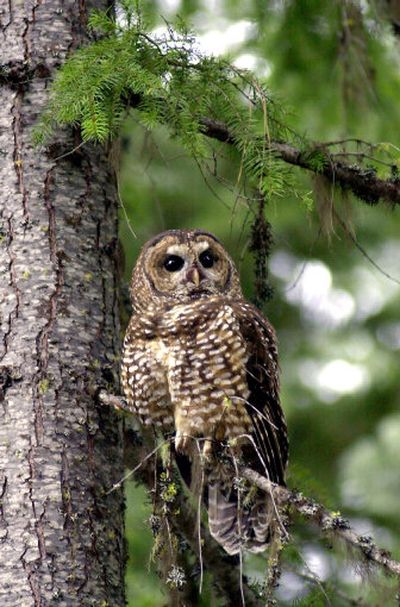Owl recovery proposal flawed, scientists say

WASHINGTON – A group of independent scientists has concluded that a draft recovery plan for the northern spotted owl was “deeply flawed,” fueling allegations that the proposal was manipulated by political appointees in Washington who were determined to boost logging in Northwest forests.
The peer review by outside scientists, requested and paid for by the U.S. Fish and Wildlife Service, found that the recovery plan disregarded 20 years of research about the owl, which lives in the region’s remaining stands of old-growth timber, and would result in reduced efforts to protect the bird and its habitat.
The review has attracted attention on Capitol Hill. Democratic lawmakers will ask Interior Secretary Dirk Kempthorne in a letter this week to withdraw the recovery plan and appoint a committee to write a new one.
“We are especially concerned the peer review has produced unanimous findings that the draft recovery plan is not based on the best available science and will not ensure recovery of the species,” the letter says.
The letter suggests that the plan may have been “tampered with by high-ranking officials within the administration,” including Julie MacDonald, a former deputy assistant interior secretary. MacDonald resigned in May amid allegations that she’d interfered with and overruled scientists working on recovery plans for various endangered species.
MacDonald was a member of the Washington Oversight Committee, which apparently instructed the spotted owl recovery team to add an option to its draft that would allow more logging in the Northwest’s forests, the congressional letter said. A related report from the administration called for reducing habitat that’s considered critical to the owl’s survival by almost one-fourth.
Other members of the Washington Oversight Committee included Mark Rey, a former timber industry lobbyist who as undersecretary at the Agriculture Department oversees the U.S. Forest Service, and Deputy Interior Secretary Lynn Scarlett.
“The politics trumped the science, and independent scientists have now blown the whistle,” said Rep. Jay Inslee, D-Wash., who circulated the letter. “White House fingerprints are all over this (recovery plan). This administration will distort science to get more gas out of the Rockies, more oil out of the Bering Sea and more timber out of the forests of the Northwest.”
Among the 20 lawmakers who had signed the letter were Rep. Nick Rahall, D-W.Va., chairman of the House Natural Resources Committee, and Rep. Henry Waxman, D-Calif., chairman of the House Oversight and Government Reform Committee.
Fish and Wildlife Service officials declined to comment on the peer review of the recovery plan, conducted by the Society of Conservation Biology and the American Ornithologists’ Union.
“We aren’t done yet,” said Joan Jewett, a spokeswoman for the Fish and Wildlife Service’s regional office in Portland. “We want the final plan to be based on the best science.”
A final recovery plan is expected to be released next spring, Jewett said.
The spotted owl, protected under the Endangered Species Act in 1990, became a symbol for efforts to halt logging in the old-growth forests of the Northwest and touched off a confrontation between environmentalists and the timber industry that lingers today.
By some estimates, between 80 percent and 90 percent of the region’s old growth has already been cut.